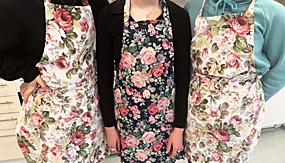
Aprons made out of old curtains. © Riihimäki
The circular economy is one of the city's key projects, and since 2019, every school in the municipality has had a person responsible for circular economy issues. Circular economy curricula have also been developed for primary and secondary schools.
"Of course, active teachers have raised the issue before, for example, in environmental education," says Maija Kojo, the head teacher at Lasitehdas Primary School.
The circular economy working group compiles a checklist of eco-activities for schools, which will help them incorporate the circular economy into their everyday lives. For example, children will be instructed to turn off lights when leaving the room, and classes will practice sorting different types of waste. Sustainable consumption is also taught through themed days, such as the clean-up days for all schools and the Jäteselviytyjä recycling competition organised by Kiertokapula.
"Even the 5th graders get excited when they get to be the guides for the 1st graders."
The circular economy is linked to an appreciation of nature, and a list of nearby nature sites is being prepared for Riihimäki schools. Observing the environment is practised together, and the pupils learn to relax without any particular tasks. "The kids like it best when we just cycle to the forest and have a snack when we get there. No disposable dishes are used, everyone carries their own mugs and water bottles."
Thriftiness teaches circular economy
The circular economy is approached with children at a very practical level. "For example, we deal together with the huge amount of lost-and-found things," says Anja Sankari, 2nd grade teacher responsible for circular economy issues at the Eteläinen School. The aim is to reduce unnecessary consumption. "We hold clothing naming and swap meets, send videos of lost and found items to children's homes and have pupils check the aisles at the end of the day."
Cutting unnecessary consumption is also reflected in procurement. Donated yarns and fabrics are used for crafts, textbooks are used sparingly, and craft materials are ordered only as much as needed. "Even birthday cards are cut with stencils to save materials, and all cardboard is used for something before it is recycled," says Sankari.
Viivi Mattheiszen, a home economics teacher responsible for circular economy issues at Harjunrinne Upper Secondary School, has noticed that thriftiness really makes the pupils' imaginations fly. "Old things are turned into new things, such as old jeans into bags, egg cartons used as kindlings and glass jars turned into lanterns. We also teach the students how to compost."
Lasitehdas Primary School, which was completed in 1915, has in itself proved to be a treasure trove for circular economy. "Last spring, we cleaned out warehouses that had been in chaos for a long time and found so many usable school supplies that we didn't have to order any new ones all year," Kojo says. The money saved was used to buy new textbooks for the school.
Using maths to fight food waste!
Harjunrinne School is part of the Green Flag eco-school programme and is also involved in the Varuke sustainable school food project. Mattheiszen's 8th-grade class got to taste a new type of sustainable school food, such as roach fish tortillas, as a test group. The students' favourites were modified into improved tasting dishes for the whole school. "Many people who avoided vegetarian food were surprised by the great taste of the food!"
Four times a year, children at the Eteläinen School get to weigh the amount of food waste in the canteen, and the competition between classes really gets the pupils excited about the subject. Maths can be used to make other choices, such as water consumption, more concrete. "The kids were amazed that just one pupil could save eight litres of water when washing his hands by not keeping the tap on all the time," says Sankari. They have also worked with pupils to see how much energy is saved by cycling to school instead of driving, or how plastic consumption was reduced when the school switched from butter buttons to butter boxes.
In Sankari's opinion, it is therefore important to pick up the circular economy themes from the everyday life of children, because there is still much in the adult world that they do not understand. "Children need to be able to do, explore and act for themselves!"
According to Viivi Mattheiszen, the circular economy should also be introduced to teenagers in a down-to-earth way. "Terms like circular economy or biodiversity are too difficult even for 13–16-year-olds. Pupils' interest is aroused and maintained in a completely different way if the subject is approached through a simple game, for example, or if young people are made to understand that even borrowing a hammer from their grandparents is circular economy. After all, they are already familiar with many circular economies."
Maija Kojo is pleased with how circular economy education no longer needs to be justified to parents. Environmental education has caught on in Riihimäki, and many practices are being taken home with children. At the same time, children and young people feel that they have the opportunity to influence big issues. "The best way to help children overcome their environmental anxiety is to tackle small issues in the local environment together."
Read more